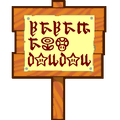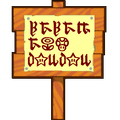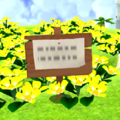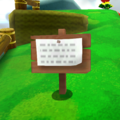User:Nintendo101/flowerpot: Difference between revisions
Nintendo101 (talk | contribs) mNo edit summary Tag: Disambiguation links |
Nintendo101 (talk | contribs) mNo edit summary |
||
| Line 8: | Line 8: | ||
'''Travel Tips''', also known as '''signs''',<ref>{{cite|quote=To read a sign or talk to someone, press the B Button. (You can talk to some people just by stopping right in front of them.) If a message is long, press the A or B Button to continue reading. Often, important hints are written on the signs.|author=[[Nintendo of America]]|date=1996|title=''Super Mario 64 Instruction Booklet''|format=PDF|url=https://m1.nintendo.net/docvc/NUS/USA/NSME/NSME_E.pdf|location=Redmond|publisher=Nintendo of America|page=8}}</ref><ref>{{cite|author=[[Nintendo of America]]|date=2005|title=''Super Mario 64 DS Instruction Booklet''|location=Redmond|publisher=Nintendo of America|page=13}}</ref><ref>{{cite|quote=While standing in front of certain characters or signs, you can press {{button|wii|a}} to speak or read.|author=[[Nintendo of America]]|date=2007|title=''Super Mario Galaxy Instruction Booklet''|format=PDF|url=https://csassets.nintendo.com/noaext/image/private/t_KA_PDF/Wii_Super_Mario_Galaxy?_a=BATCtdAA0|location=Redmond|publisher=Nintendo of America|page=13}}</ref> '''signboards''',<ref>{{cite|quote=Stand in front of certain characters and press the A Button to talk to them, or stand in front of signboards and press the A Button to read them.|author=[[Nintendo|Nintendo of Europe]]|date=2010|title=''Super Mario Galaxy 2 Instruction Booklet''|format=PDF|url=https://m1.nintendo.net/docvc/RVL/EUR/SB4P/SB4P_E.pdf|location=Großostheim|publisher=Nintendo of Europe|page=18}}</ref> or '''boards''', are guideposts in the ''[[Super Mario (franchise)|Super Mario]]'' franchise that debuted in ''[[Super Mario 64]]''. In all appearances, a Travel Tip provides information on an available action or the current level when prompted. Travel Tips are either staked into the ground like [[Stump|post]]s, or attached to the side of walls. Staked Travel Tips often have a secondary interactive element. | '''Travel Tips''', also known as '''signs''',<ref>{{cite|quote=To read a sign or talk to someone, press the B Button. (You can talk to some people just by stopping right in front of them.) If a message is long, press the A or B Button to continue reading. Often, important hints are written on the signs.|author=[[Nintendo of America]]|date=1996|title=''Super Mario 64 Instruction Booklet''|format=PDF|url=https://m1.nintendo.net/docvc/NUS/USA/NSME/NSME_E.pdf|location=Redmond|publisher=Nintendo of America|page=8}}</ref><ref>{{cite|author=[[Nintendo of America]]|date=2005|title=''Super Mario 64 DS Instruction Booklet''|location=Redmond|publisher=Nintendo of America|page=13}}</ref><ref>{{cite|quote=While standing in front of certain characters or signs, you can press {{button|wii|a}} to speak or read.|author=[[Nintendo of America]]|date=2007|title=''Super Mario Galaxy Instruction Booklet''|format=PDF|url=https://csassets.nintendo.com/noaext/image/private/t_KA_PDF/Wii_Super_Mario_Galaxy?_a=BATCtdAA0|location=Redmond|publisher=Nintendo of America|page=13}}</ref> '''signboards''',<ref>{{cite|quote=Stand in front of certain characters and press the A Button to talk to them, or stand in front of signboards and press the A Button to read them.|author=[[Nintendo|Nintendo of Europe]]|date=2010|title=''Super Mario Galaxy 2 Instruction Booklet''|format=PDF|url=https://m1.nintendo.net/docvc/RVL/EUR/SB4P/SB4P_E.pdf|location=Großostheim|publisher=Nintendo of Europe|page=18}}</ref> or '''boards''', are guideposts in the ''[[Super Mario (franchise)|Super Mario]]'' franchise that debuted in ''[[Super Mario 64]]''. In all appearances, a Travel Tip provides information on an available action or the current level when prompted. Travel Tips are either staked into the ground like [[Stump|post]]s, or attached to the side of walls. Staked Travel Tips often have a secondary interactive element. | ||
The player is rarely obligated to read Travel Tips. They are | The player is rarely obligated to read Travel Tips. Rather, they are available at their discretion. They are comparable to [[Message Block]]s. In ''[[Super Mario Galaxy]]'' and ''[[Super Mario Galaxy 2]]'', there are a few boards that are [[Boards (characters)|conscious, speaking characters]]. | ||
==History== | ==History== | ||
===''Super Mario'' series=== | ===''Super Mario'' series=== | ||
====''Super Mario 64'' / ''Super Mario 64 DS''==== | ====''Super Mario 64'' / ''Super Mario 64 DS''==== | ||
Signs can be read by the player character in ''[[Super Mario 64]]'' and ''[[Super Mario 64 DS]]''. They were incorporated to compensate for the diversity of moves the developers included in the game, which they worried would intimidate some players. At the same time, they did not want to impose instructions onto them, especially if they became more experienced overtime. | |||
Typically, signs provide information on a move the player can perform, or contextualize a potentially cryptic detail in the environment. The signs that are staked into the ground can be [[Ground Pound|ground-pounded]] by the player character, rendering it unreadable unless they exit and reenter the course. Like [[stump|post]]s, it takes [[Mario]] and most of the other playable characters in ''Super Mario 64 DS'' three strikes to fully bury the sign. It takes [[Wario]] only one. Signs otherwise occur pinned to walls. The one in the courtyard is the source for the infamous "L is real" urban legend. | |||
====''Super Mario Sunshine''==== | ====''Super Mario Sunshine''==== | ||
| Line 25: | Line 27: | ||
====''Super Mario Odyssey''==== | ====''Super Mario Odyssey''==== | ||
Signs that contain information on actions. Some are fastened to walls, while others are staked into the ground. Like Arrow Signs, staked Travel Tips spin when struck by Cappy. | Signs that contain information on actions. Some are fastened to walls, while others are staked into the ground. Like Arrow Signs, staked Travel Tips spin when struck by Cappy. ("Traveling Tip" is the in-game name in Super Mario Odyssey, but "sign" is a bit more ubiquitous. I highly doubt the NS remake of TTYD will call them "Traveling Tips", but that doesn't necessarily invalidate the more specific "Traveling Tip". Games sometimes employ more general, passive terms for subjects in-game and instead apply more specific terms outside of them, such as "octopus" for Roctos.) | ||
====''Super Mario Bros. Wonder''==== | ====''Super Mario Bros. Wonder''==== | ||
| Line 32: | Line 34: | ||
===''Paper Mario'' series=== | ===''Paper Mario'' series=== | ||
====''Paper Mario''==== | ====''Paper Mario''==== | ||
called a "signboard" in the [[Close Call (badge)]] prediction. | called a "signboard" in the [[Close Call (badge)]] prediction. (If this thing just displays the map, then I don't think it belongs here.) | ||
====''Paper Mario: The Thousand-Year Door''==== | ====''Paper Mario: The Thousand-Year Door''==== | ||
| Line 38: | Line 40: | ||
====''Super Paper Mario''==== | ====''Super Paper Mario''==== | ||
dunno | |||
====''Paper Mario: Sticker Star''==== | |||
dunno | |||
====''Paper Mario: Color Splash''==== | |||
dunno | |||
====''Paper Mario: The Origami King''==== | |||
dunno | |||
===''Mario & Luigi'' series=== | |||
====''Mario & Luigi: Superstar Saga'' / ''Mario & Luigi: Superstar Saga + Bowser's Minions''==== | |||
dunno | |||
====''Mario & Luigi: Partners in Time''==== | |||
dunno | |||
====''Mario & Luigi: Bowser's Inside Story'' / ''Mario & Luigi: Bowser's Inside Story + Bowser Jr.'s Journey''==== | |||
dunno | |||
====''Mario & Luigi: Dream Team''==== | |||
dunno | |||
====''Mario & Luigi: Paper Jam''==== | |||
dunno | dunno | ||
| Line 51: | Line 78: | ||
SMG Screenshot Board.png|''Super Mario Galaxy'' | SMG Screenshot Board.png|''Super Mario Galaxy'' | ||
SMG2 Screenshot Board.png|''[[Super Mario Galaxy 2]]'' | SMG2 Screenshot Board.png|''[[Super Mario Galaxy 2]]'' | ||
PMTOK Battle Lab.jpg|''[[Paper Mario: The Origami King]]'' | |||
</gallery> | </gallery> | ||
==Names in other languages== | ==Names in other languages== | ||
{{foreign names | {{foreign names | ||
|Jap=看板 | |Jap={{ruby|看板|かんばん}}<ref>{{cite|author=[[Nintendo|Nintendo Co., Ltd.]]|date=1997|title=『Super Mario 64 振動パック対応バージョン {{ruby|取扱説明書|とりあつかいせつめいしょ}}』|format=PDF|url=https://m1.nintendo.net/docvc/NUS/JPN/NSMJ/NSMJ_J.pdf|language=Japanese|location=Tokyo|publisher=Nintendo Co., Ltd.|page=8}}</ref><ref>{{cite|author=[[Nintendo|Nintendo Co., Ltd.]]|date=2004|title=『Super Mario 64 DS {{ruby|取扱説明書|とりあつかいせつめいしょ}}』|format=PDF|url=https://m1.nintendo.net/docvc/NTR/JPN/ASMJ/ASMJ_J.pdf|language=Japanese|location=Tokyo|publisher=Nintendo Co., Ltd.|page=11}}</ref><ref>{{cite|author=[[Nintendo|Nintendo Co., Ltd.]]|date=2007|title=『Super Mario Galaxy {{ruby|取扱説明書|とりあつかいせつめいしょ}}』|format=PDF|url=https://m1.nintendo.net/docvc/RVL/JPN/RMGJ/RMGJ_J.pdf|language=Japanese|location=Tokyo|publisher=Nintendo Co., Ltd.|page=16}}</ref><ref>{{cite|author=[[Nintendo|Nintendo Co., Ltd.]]|date=2010|title=『Super Mario Galaxy 2 {{ruby|取扱説明書|とりあつかいせつめいしょ}}』|format=PDF|url=https://m1.nintendo.net/docvc/RVL/JPN/SB4J/SB4J_J.pdf|language=Japanese|location=Tokyo|publisher=Nintendo Co., Ltd.|page=18}}</ref> | ||
|JapR=Kanban | |JapR=Kanban | ||
|JapM=Signboard | |JapM=Signboard | ||
|Fre=Affiche<ref>{{cite|author=[[Nintendo of America]]|date=2007|title=''Super Mario Galaxy Instruction Booklet''|format=PDF|url=https://csassets.nintendo.com/noaext/image/private/t_KA_PDF/Wii_Super_Mario_Galaxy?_a=BATCtdAA0|language=French|location=Redmond|publisher=Nintendo of America|page=35}}</ref> | |||
|FreM=Poster | |||
|Spa=Signo<ref>{{cite|author=[[Nintendo of America]]|date=2007|title=''Super Mario Galaxy Instruction Booklet''|format=PDF|url=https://csassets.nintendo.com/noaext/image/private/t_KA_PDF/Wii_Super_Mario_Galaxy?_a=BATCtdAA0|language=Spanish|location=Redmond|publisher=Nintendo of America|page=57}}</ref> | |||
|SpaM=Sign | |||
}} | }} | ||
==See also== | ==See also== | ||
{{columns| | |||
*[[Arrow Sign]] | *[[Arrow Sign]] | ||
*[[Hint Art]] | *[[Hint Art]] | ||
*[[No Animal Sign]] | |||
*[[Rankings Board]] | *[[Rankings Board]] | ||
*[[Standee]] | |||
*[[Star Coin Sign]] | *[[Star Coin Sign]] | ||
*[[Stump]] | *[[Stump]] | ||
*[[Tip Network]] | *[[Tip Network]] | ||
*[[Starship Mario#Totals Sign|Totals Sign]] | |||
*[[Wooden cutout]] | *[[Wooden cutout]] | ||
}} | |||
==References== | ==References== | ||
{{NIWA|Ukikipedia=Sign}} | |||
<references/> | <references/> | ||
{{Nav templates| | |||
{{SM64}} | {{SM64}} | ||
{{PM}} | {{PM}} | ||
| Line 78: | Line 117: | ||
{{SPM}} | {{SPM}} | ||
{{SMG}} | {{SMG}} | ||
{{M&LBIS}} | |||
{{SMG2}} | {{SMG2}} | ||
{{PMSS}} | |||
{{M&LDT}} | |||
{{SMO}} | {{SMO}} | ||
{{PMTOK}} | |||
{{SMBW}} | {{SMBW}} | ||
}} | |||
Revision as of 15:30, April 27, 2024
| flowerpot | |
|---|---|
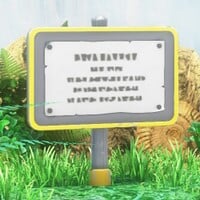 Screenshot from Super Mario Odyssey | |
| First appearance | Super Mario 64 (1996) |
| Latest appearance | Super Mario Bros. Wonder (2023) |
| Effect | Provides information when read. |
Travel Tips, also known as signs,[1][2][3] signboards,[4] or boards, are guideposts in the Super Mario franchise that debuted in Super Mario 64. In all appearances, a Travel Tip provides information on an available action or the current level when prompted. Travel Tips are either staked into the ground like posts, or attached to the side of walls. Staked Travel Tips often have a secondary interactive element.
The player is rarely obligated to read Travel Tips. Rather, they are available at their discretion. They are comparable to Message Blocks. In Super Mario Galaxy and Super Mario Galaxy 2, there are a few boards that are conscious, speaking characters.
History
Super Mario series
Super Mario 64 / Super Mario 64 DS
Signs can be read by the player character in Super Mario 64 and Super Mario 64 DS. They were incorporated to compensate for the diversity of moves the developers included in the game, which they worried would intimidate some players. At the same time, they did not want to impose instructions onto them, especially if they became more experienced overtime.
Typically, signs provide information on a move the player can perform, or contextualize a potentially cryptic detail in the environment. The signs that are staked into the ground can be ground-pounded by the player character, rendering it unreadable unless they exit and reenter the course. Like posts, it takes Mario and most of the other playable characters in Super Mario 64 DS three strikes to fully bury the sign. It takes Wario only one. Signs otherwise occur pinned to walls. The one in the courtyard is the source for the infamous "L is real" urban legend.
Super Mario Sunshine
Posted signs that contain information on actions.
Super Mario Galaxy
Posted signs that contain information on actions. Most Boards are inanimate objects that give Mario insight on his surroundings or actions when read. However, a few Boards are speaking characters that give specific instructions on how to use objects or power-ups that change how Mario is controlled.
Super Mario Galaxy 2
Posted signs that contain information on actions. One of them is a speaking character.
Super Mario Odyssey
Signs that contain information on actions. Some are fastened to walls, while others are staked into the ground. Like Arrow Signs, staked Travel Tips spin when struck by Cappy. ("Traveling Tip" is the in-game name in Super Mario Odyssey, but "sign" is a bit more ubiquitous. I highly doubt the NS remake of TTYD will call them "Traveling Tips", but that doesn't necessarily invalidate the more specific "Traveling Tip". Games sometimes employ more general, passive terms for subjects in-game and instead apply more specific terms outside of them, such as "octopus" for Roctos.)
Super Mario Bros. Wonder
appear on the world map
Paper Mario series
Paper Mario
called a "signboard" in the Close Call (badge) prediction. (If this thing just displays the map, then I don't think it belongs here.)
Paper Mario: The Thousand-Year Door
dunno
Super Paper Mario
dunno
Paper Mario: Sticker Star
dunno
Paper Mario: Color Splash
dunno
Paper Mario: The Origami King
dunno
Mario & Luigi series
Mario & Luigi: Superstar Saga / Mario & Luigi: Superstar Saga + Bowser's Minions
dunno
Mario & Luigi: Partners in Time
dunno
Mario & Luigi: Bowser's Inside Story / Mario & Luigi: Bowser's Inside Story + Bowser Jr.'s Journey
dunno
Mario & Luigi: Dream Team
dunno
Mario & Luigi: Paper Jam
dunno
Gallery
Names in other languages
| Language | Name | Meaning |
|---|---|---|
| Japanese | Kanban |
Signboard |
| French | Affiche[9] |
Poster |
| Spanish | Signo[10] |
Sign |
See also
References
- ^ "To read a sign or talk to someone, press the B Button. (You can talk to some people just by stopping right in front of them.) If a message is long, press the A or B Button to continue reading. Often, important hints are written on the signs." – Nintendo of America (1996). Super Mario 64 Instruction Booklet (PDF). Redmond: Nintendo of America. Page 8.
- ^ Nintendo of America (2005). Super Mario 64 DS Instruction Booklet. Redmond: Nintendo of America. Page 13.
- ^ "While standing in front of certain characters or signs, you can press
 to speak or read." – Nintendo of America (2007). Super Mario Galaxy Instruction Booklet (PDF). Redmond: Nintendo of America. Page 13.
to speak or read." – Nintendo of America (2007). Super Mario Galaxy Instruction Booklet (PDF). Redmond: Nintendo of America. Page 13.
- ^ "Stand in front of certain characters and press the A Button to talk to them, or stand in front of signboards and press the A Button to read them." – Nintendo of Europe (2010). Super Mario Galaxy 2 Instruction Booklet (PDF). Großostheim: Nintendo of Europe. Page 18.
- ^ Nintendo Co., Ltd. (1997). 『Super Mario 64 振動パック対応バージョン
取扱説明書 』 (PDF). Tokyo: Nintendo Co., Ltd. (Japanese). Page 8. - ^ Nintendo Co., Ltd. (2004). 『Super Mario 64 DS
取扱説明書 』 (PDF). Tokyo: Nintendo Co., Ltd. (Japanese). Page 11. - ^ Nintendo Co., Ltd. (2007). 『Super Mario Galaxy
取扱説明書 』 (PDF). Tokyo: Nintendo Co., Ltd. (Japanese). Page 16. - ^ Nintendo Co., Ltd. (2010). 『Super Mario Galaxy 2
取扱説明書 』 (PDF). Tokyo: Nintendo Co., Ltd. (Japanese). Page 18. - ^ Nintendo of America (2007). Super Mario Galaxy Instruction Booklet (PDF). Redmond: Nintendo of America (French). Page 35.
- ^ Nintendo of America (2007). Super Mario Galaxy Instruction Booklet (PDF). Redmond: Nintendo of America (Spanish). Page 57.




